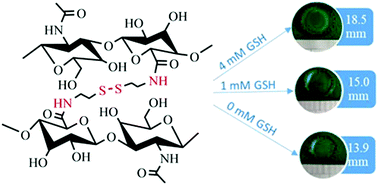A redox-responsive hyaluronic acid-based hydrogel for chronic wound management†
Abstract
Polymer-based hydrogels have been widely applied for chronic wound therapeutics, due to their well-acclaimed wound exudate management capability. At the same time, there is still an unmet clinical need for simple wound diagnostic tools to assist clinical decision-making at the point of care and deliver on the vision of patient-personalised wound management. To explore this challenge, we present a one-step synthetic strategy to realise a redox-responsive, hyaluronic acid (HA)-based hydrogel that is sensitive to wound environment-related variations in glutathione (GSH) concentration. By selecting aminoethyl disulfide (AED) as a GSH-sensitive crosslinker and considering GSH concentration variations in active and non-self-healing wounds, we investigated the impact of GSH-induced AED cleavage on hydrogel dimensions, aiming to build GSH-size relationships for potential point-of-care wound diagnosis. The hydrogel was also found to be non-cytotoxic and aided L929 fibroblast growth and proliferation over seven days in vitro. Such a material offers a very low-cost tool for the visual detection of a target analyte that varies dependent on the status of the cells and tissues (wound detection), and may be further exploited as an implant for fibroblast growth and tissue regeneration (wound repair).



 Please wait while we load your content...
Please wait while we load your content...